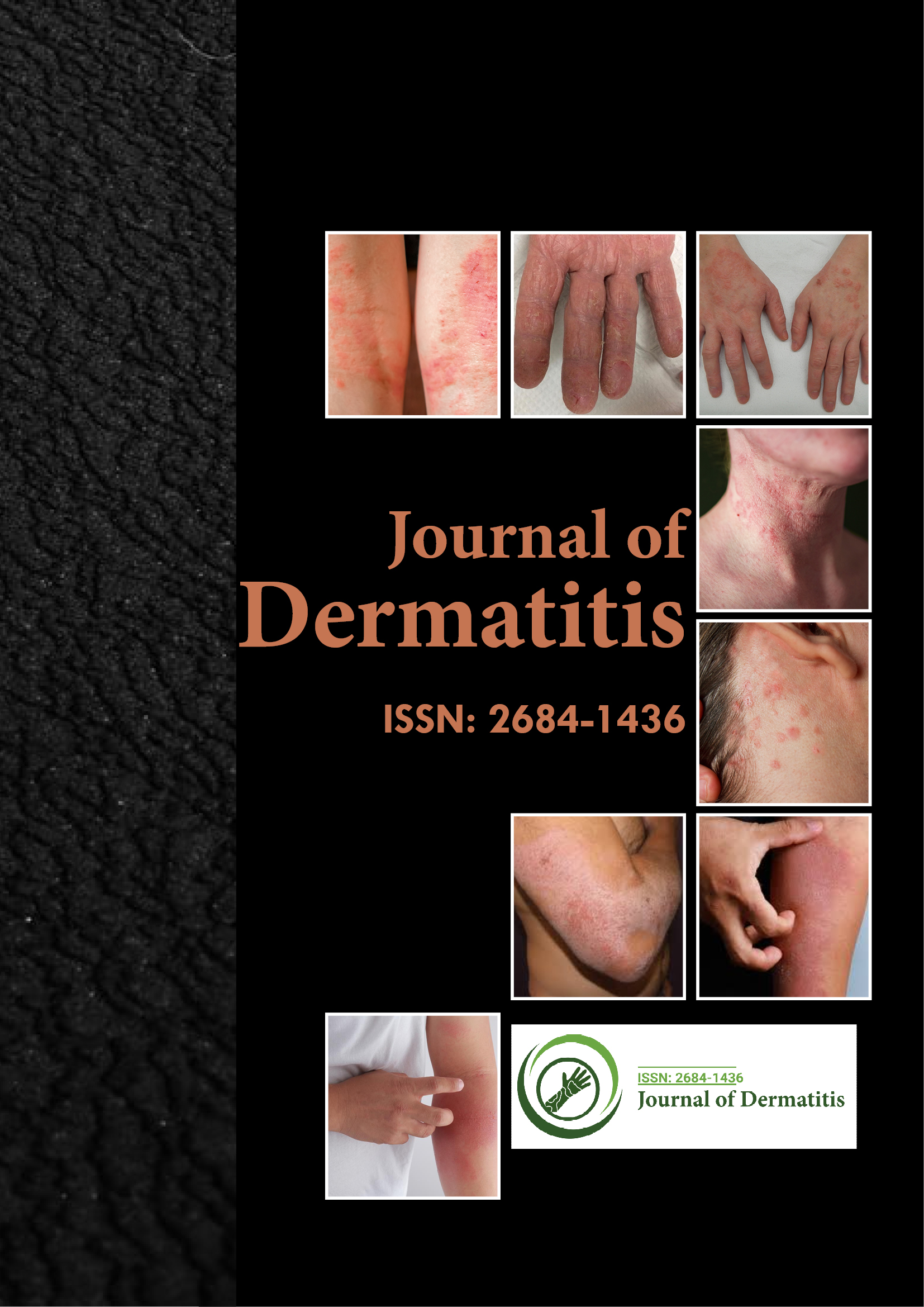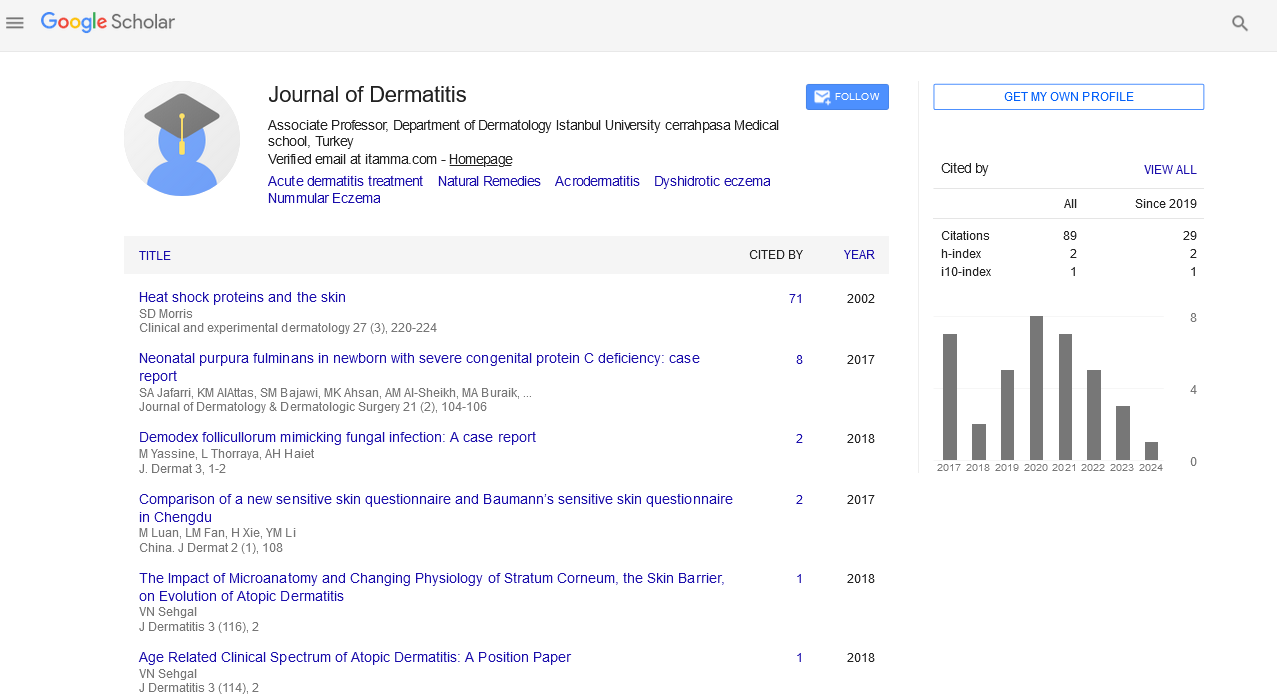Indexed In
- RefSeek
- Hamdard University
- EBSCO A-Z
- Euro Pub
- Google Scholar
Useful Links
Share This Page
Journal Flyer

Open Access Journals
- Agri and Aquaculture
- Biochemistry
- Bioinformatics & Systems Biology
- Business & Management
- Chemistry
- Clinical Sciences
- Engineering
- Food & Nutrition
- General Science
- Genetics & Molecular Biology
- Immunology & Microbiology
- Medical Sciences
- Neuroscience & Psychology
- Nursing & Health Care
- Pharmaceutical Sciences
Perspective - (2024) Volume 9, Issue 4
Nummular Eczema: Advances in Pathogenesis and Implications for Targeted Therapies
Akiko Mori*Received: 29-Nov-2024, Manuscript No. JOD-24-28249; Editor assigned: 02-Dec-2024, Pre QC No. JOD-24-28249 (PQ); Reviewed: 16-Dec-2024, QC No. JOD-24-28249; Revised: 23-Dec-2024, Manuscript No. JOD-24-28249 (R); Published: 30-Dec-2024, DOI: 10.35248/2684-1436.24.9.249
Description
Nummular eczema, also known as nummular dermatitis, is a chronic, inflammatory skin disorder characterized by disc shaped erythematous, scaly plaques that typically present on the extremities. While often classified as a separate entity, emerging evidence suggests that nummular eczema may represent a variant of Atopic Dermatitis (AD), carry by a complex exchange of immune responses, including codominant T(H)2 and T(H)17 pathways. This perspective explores the evolving understanding of nummular eczema’s pathogenesis, highlights its relationship to atopic dermatitis and examines the implications for personalized therapeutic approaches.
The pathophysiology of nummular eczema, much like atopic dermatitis, involves a dysfunctional skin barrier and aberrant immune responses. Central to this dysfunction is the disruption of the epidermal barrier, which facilitates increased transepidermal water loss and allows for the penetration of environmental allergens and irritants. While mutations in the FLG gene encoding filaggrin-a critical protein for maintaining skin barrier integrity-are common in classic atopic dermatitis, such mutations have also been identified in patients with nummular eczema, supporting the idea of a shared molecular basis. This overlap reinforces the hypothesis that nummular eczema may be a phenotypic variant of AD rather than a distinct entity.What sets nummular eczema apart from classic atopic dermatitis is its unique immunological profile. Recent research has demonstrated that nummular eczema is characterized by a codominant T(H)2 and T(H)17 immune response. T(H)2 cells, which are central to the pathogenesis of classic AD, mediate allergic inflammation by releasing cytokines such as interleukin-4 (IL-4), IL-5 and IL-13. These cytokines promote immunoglobulin E (IgE) production, mast cell activation and eosinophilic inflammation, which contribute to the hallmark pruritus and chronicity of atopic dermatitis. Similarly, T(H)2 skewing in nummular eczema likely underpins its hypersensitivity to environmental allergens and its association with a history of atopy in some patients.
However, unlike classic AD, nummular eczema exhibits a concurrent T(H)17-driven inflammatory axis. T(H)17 cells produce cytokines such as IL-17 and IL-22, which contribute to neutrophilic inflammation and impair epidermal barrier repair mechanisms. These cytokines have been implicated in other inflammatory skin diseases, such as psoriasis, highlighting the overlapping immune pathways in different dermatoses. The presence of T(H)17-driven inflammation in nummular eczema provides a plausible explanation for its more sharply demarcated lesions, hyperkeratosis and tendency to resist conventional therapies primarily targeting T(H)2 inflammation.
The codominance of T(H)2 and T(H)17 responses in nummular eczema also aligns with its clinical presentation and response to treatment. Patients with nummular eczema often report intense pruritus, similar to classic atopic dermatitis, but also display features more commonly associated with psoriasis, such as thickened plaques and neutrophilic pustules in severe cases. These observations highlight the importance of considering nummular eczema within the spectrum of AD while acknowledging its unique immunological signature.
From a therapeutic perspective, the recognition of T(H)2 and T(H)17 codominance in nummular eczema has significant implications for treatment strategies. Traditional therapies for atopic dermatitis, including topical corticosteroids, calcineurin inhibitors and emollients, remain the mainstay for managing nummular eczema. These treatments primarily target T(H)2- mediated inflammation and aim to restore skin barrier function. While effective for many patients, they may fall short in addressing the T(H)17-driven components of the disease, particularly in refractory or severe cases.
The advent of targeted immunotherapies has opened new methods for treating nummular eczema. Dupilumab, a monoclonal antibody targeting the IL-4 receptor alpha and inhibiting T(H)2 cytokines IL-4 and IL-13, has demonstrated efficacy in atopic dermatitis and may benefit patients with nummular eczema. However, given the role of T(H)17-driven inflammation, therapies targeting IL-17 or IL-23, such as secukinumab or ustekinumab, may provide additional benefit for patients with nummular eczema exhibiting features of psoriasis or resistance to T(H)2-targeted therapies.
In conclusion, nummular eczema occupies a unique position within the spectrum of atopic dermatitis, distinguished by its codominant T(H)2/T(H)17 immune response. This duality not only defines its clinical presentation but also influences its therapeutic challenges and opportunities. As our understanding of its pathogenesis evolves, integrating targeted immunotherapies and personalized treatment approaches will be key to improving outcomes for patients with this complex and often refractory skin condition. Recognizing nummular eczema as more than just a morphological variant of atopic dermatitis is essential for advancing its diagnosis, treatment and overall patient care.
Citation: Mori A (2024). Nummular Eczema: Advances in Pathogenesis and Implications for Targeted Therapies. J Dermatitis. 9:249.
Copyright: © 2024 Mori A. This is an open access article distributed under the terms of the Creative Commons Attribution License, which permits unrestricted use, distribution, and reproduction in any medium, provided the original author and source are credited.

